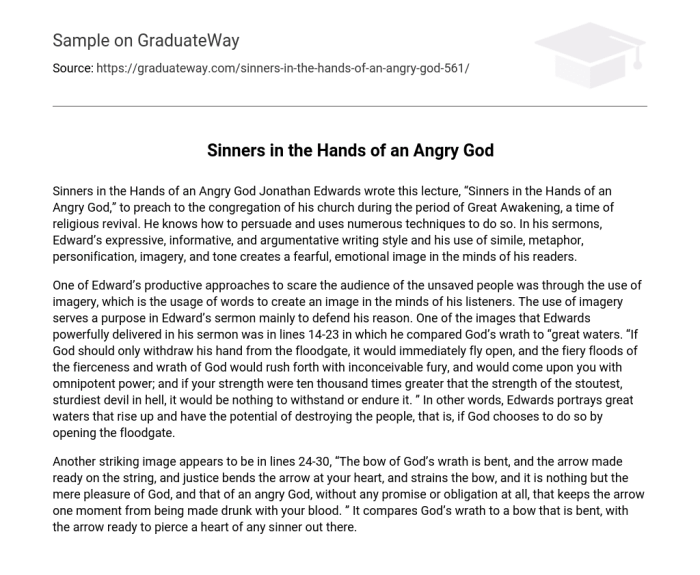Sinners in the hands of an angry god rhetorical analysis – Jonathan Edwards’ sermon “Sinners in the Hands of an Angry God” stands as a prime example of persuasive rhetoric, employing a range of rhetorical devices to evoke intense emotional responses and inspire immediate repentance. This analysis delves into the sermon’s masterful use of language, imagery, and structure to achieve its persuasive aims.
1. Rhetorical Devices

Edwards employs a range of rhetorical devices to evoke strong emotions and persuade his audience. Metaphors, such as “sinners in the hands of an angry God,” create vivid images that connect with the audience’s fears and insecurities.
Similes, such as “the wrath of God is like a consuming fire,” emphasize the intensity and destructiveness of God’s anger. Personification, as in “God stands ready to pierce you with his arrows,” attributes human qualities to God, making his wrath seem more immediate and personal.
2. Language and Imagery

Edwards uses vivid and descriptive language to create a sense of urgency and fear. The imagery of fire and brimstone reinforces the sermon’s message of eternal damnation. The repetition of words like “hell,” “fire,” and “damnation” drives home the severity of the consequences of sin.
3. Structure and Organization: Sinners In The Hands Of An Angry God Rhetorical Analysis
The sermon follows a logical progression, building from the premise of God’s wrath to the consequences of sin and the need for repentance. Edwards uses repetition and parallelism to emphasize his points, such as the repetition of the phrase “there is no safety” to highlight the hopelessness of sinners.
4. Audience and Context
The sermon was delivered to a Puritan audience in the 18th century. Edwards’ language and imagery were tailored to their religious beliefs and fears. The sermon’s focus on personal sin and the threat of eternal damnation resonated deeply with his listeners.
5. Emotional Appeal
Edwards employs emotional appeals to persuade his audience. He uses fear and guilt to motivate his listeners to repent and seek salvation. By emphasizing the horrors of hell and the wrath of God, he creates a sense of urgency that compels his listeners to take action.
6. Call to Action
Edwards concludes the sermon with a clear call to action. He urges his listeners to repent and turn to God for salvation. He provides specific instructions on how to do so, such as praying, confessing sins, and seeking guidance from the Bible.
7. Comparison to Other Sermons

Edwards’ sermon is similar to other Puritan sermons in its use of vivid imagery, emotional appeals, and logical arguments. However, it is distinguished by its intense focus on personal sin and the threat of eternal damnation. Edwards’ sermon is considered one of the most powerful and influential sermons in American history.
Essential FAQs
What is the main argument of Edwards’ sermon?
Edwards argues that sinners are in imminent danger of eternal damnation due to their sinfulness and God’s wrath.
How does Edwards use metaphors to persuade his audience?
Edwards employs vivid metaphors, such as sinners hanging over the pit of hell by a slender thread, to create a sense of urgency and fear.
What is the significance of the imagery of fire and brimstone in the sermon?
Edwards uses imagery of fire and brimstone to convey the intensity and severity of God’s punishment for sin.